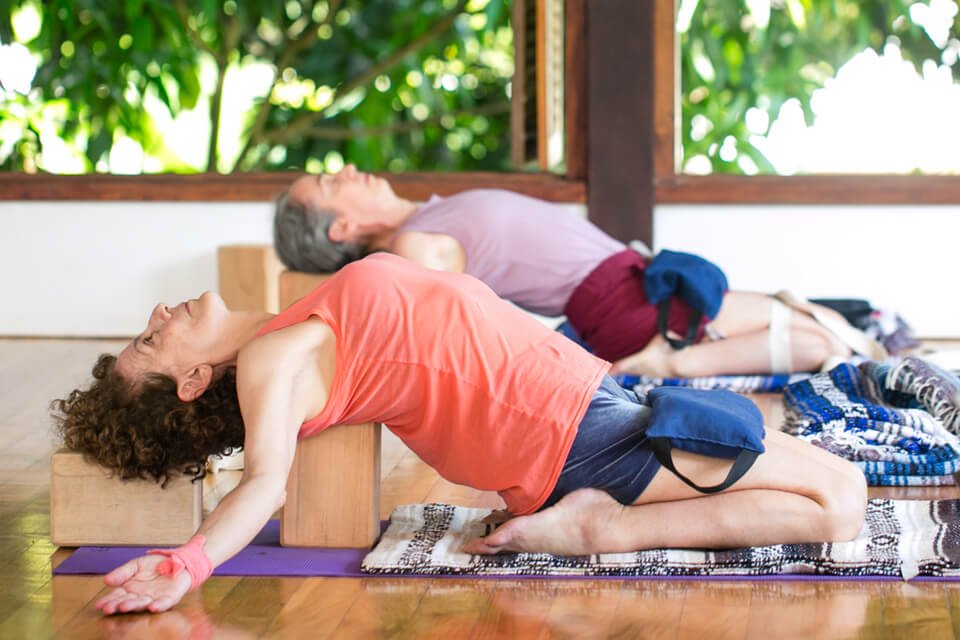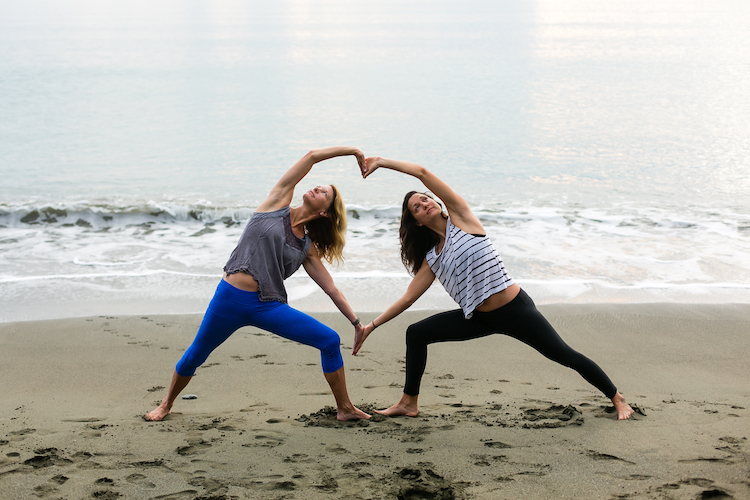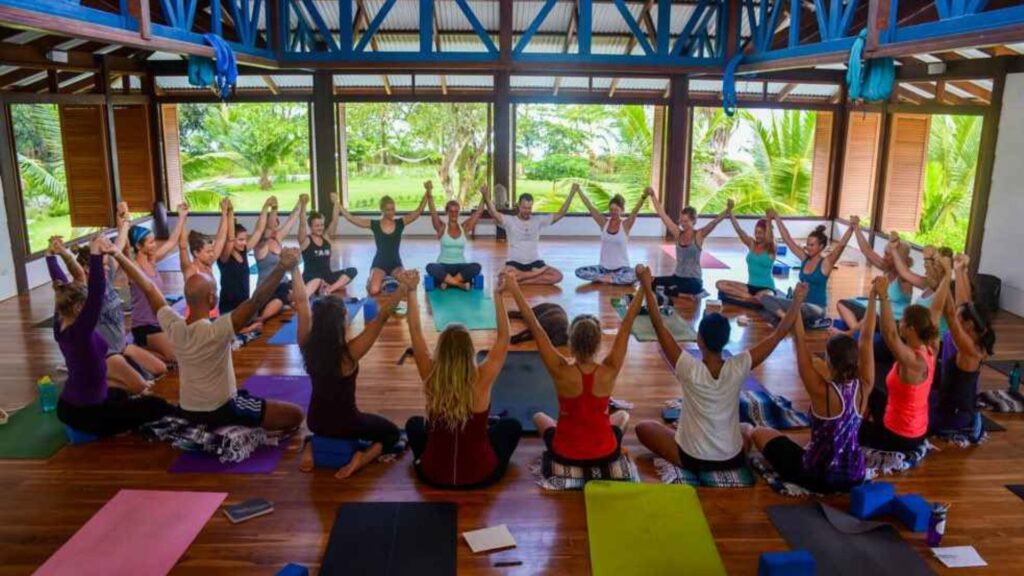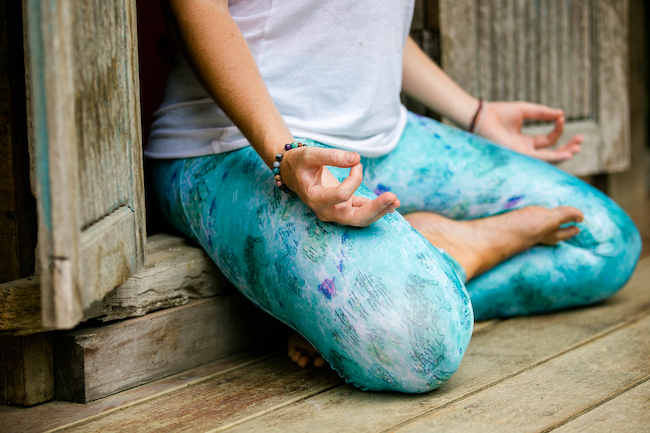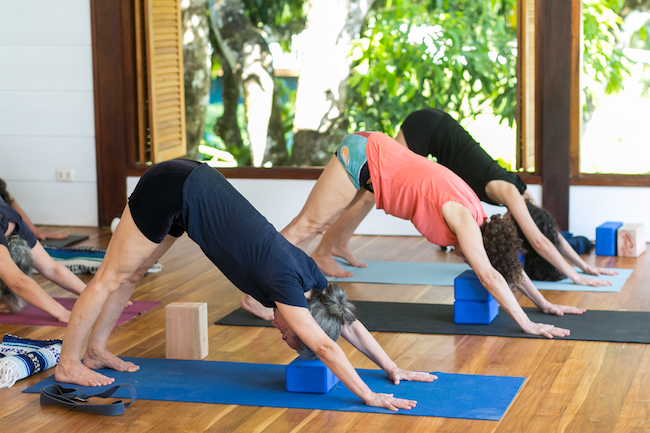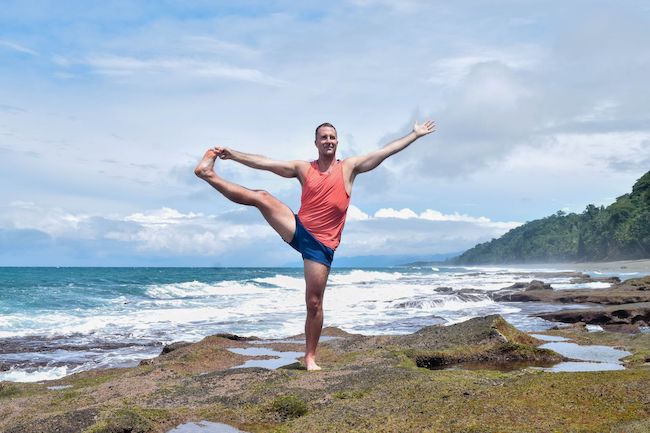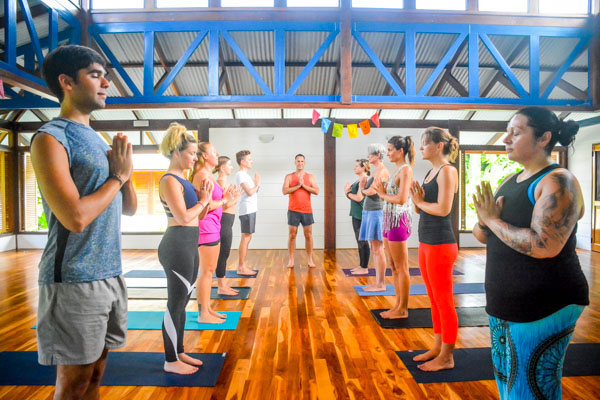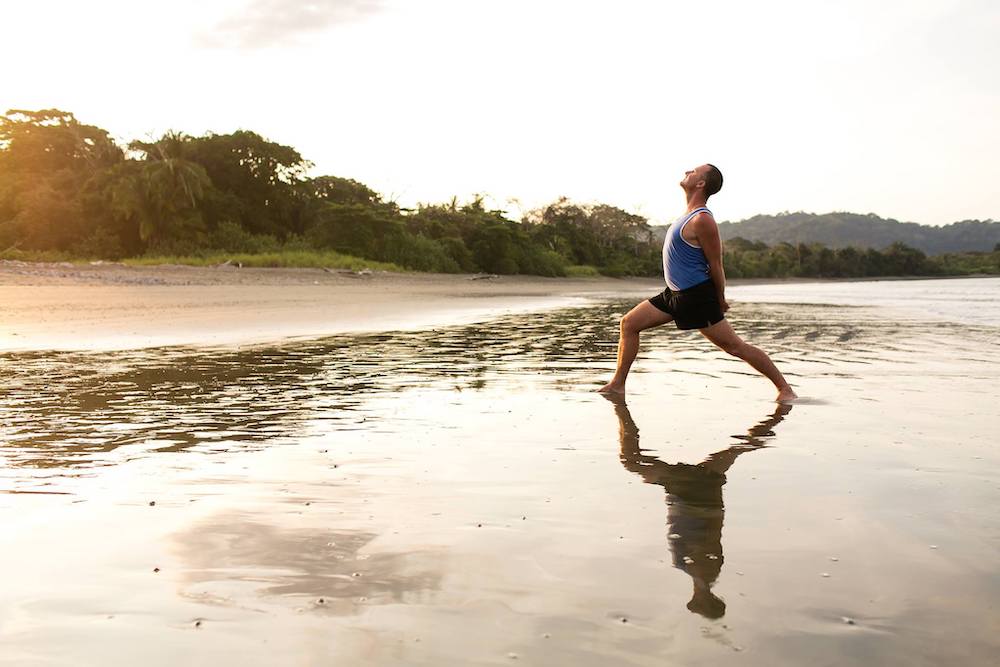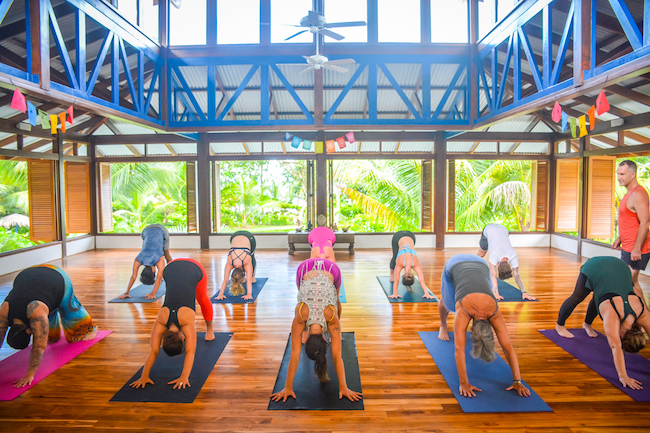A yoga retreat is more than practicing yoga in a different space. It is a community-building experience that allows you to deepen your yoga practice and help others do the same. So how can you achieve this goal while also selling out your yoga retreat? Well, here is where we can help.
Yoga retreats can also help you experience a new part of the world and connect with a deeper part of yourself. Many of us are familiar with the 60-minute class in a studio and then returning back to our normal and most often, chaotic lives – and many of us need a break from this mayhem and a chance to “get away”.
This is where a yoga retreat can be beneficial. To help reset the body and mind while also reconnecting with nature and healing yourself. But first, understanding how to host your own yoga retreat around the world is important to consider before you begin to sell out your retreat.
So you’ve made the choice to host a retreat and want to know what to do next. Below are some key tips on how to sell out your yoga retreat and ensure that your experience is not only positive but also transformative.
WHY Should I Host a Yoga Retreat?
The first question you should ask yourself is about your purpose. Why do I want to lead a yoga retreat? What is my purpose? The success of your retreat will all depend on this question. Some examples of your WHY could be:
- To separate yourself from life and work and sink into a deeper practice
- To connect with your deeper self and help others do the same
- To create a like-minded yoga community and help people transform
If your intention is ego, stop now. Hosting a retreat is a lot of work and the thanks and gratitude you receive will not pay off. Think about what to base your intention on (community, travel, experience). Before reading on, take a moment to think about your why. Write it down and reflect on your purpose.
What is the First Step to Selling Out a Yoga Retreat?
One of the number one reasons why yoga retreats fail is because of a lack of interest. For example, people may not want to travel with you or they may not know about the retreat in the first place. It is critical to ask your students if they want to travel with you. Start by advertising your experience of a place you may have visited to understand if your students are interested.
Let your students know where you are. Share your thoughts and see how your students interact. One of the best ways to do this is to create a survey. This can be about 10 questions varying from the location of the retreat to the time of year. It can even include what budget your students have and the types of food they like. You can even start to think about what type of retreat you would like to host. For example, a spirituality and psychedelic retreat. Or even a retreat focused on team building or leading a corporate getaway. Here are five myths about team building and advice on how to keep your cool during team building activities on your corporate retreat. There are many different kinds so think about what interests you!
A survey enables you to become more in touch with your students while also putting the idea of a retreat on their minds. People love to share their opinions and give advice. This will also start to get your students thinking about a retreat. So when it comes time to launch your retreat, your students already have the idea in their minds.
Before moving on, come up with some questions that are important to you that you would like to ask of your students.
What Kinds of Students Should I Have for my Yoga Retreat?
Once you have established the kind of retreat you would like to host you need to think about what type of student you want to attract. This is a key step to help you prepare for marketing material.
In the yoga community, yoga is inclusive and for everyone. But within the yoga world, there are many different aspects to the practice. As the host, think about what type of students you want to go with you on your retreat and be honest. Creating a retreat that is open to everyone is okay. But you will attract a certain audience based on your own teaching style. For example, if you teach a restorative practice, you will most likely attract students who are into restorative yoga. We want to teach people who are drawn to the practices we are teaching. When thinking about your retreat, think about what kind of leader YOU are.
There are many styles of retreats that involve a range of prices. Higher-end retreats usually have higher-end demands. Meaning that your students will expect more. Consider if this is something you want and can adhere to. Honest advertising is also critical. For example, some retreats might involve a lot of hiking. Make sure that you let your students know this beforehand. Be specific with your information. It’s a good practice to state who your retreat is for and who it is not for. Preparing your students for what to expect is essential to help maintain a happy community. Ensuring that you ask important questions is also key. For example, what are your student’s dietary needs? If you are unable to provide meat in the meal plan, let your students know this. This is one way to get the right students.
Before moving on, think about the qualities of the kinds of people you would like to attract on your yoga retreat.
Why You Should Make a Yoga Retreat Scouting Trip
One big question you may ask is, where do I start leading a yoga retreat? At first, try to make your retreat something that people can’t say no to. This can mean hosting something close to home and making it affordable. This is a great way to have a platform to build off of and allow your retreats to then go further. Then the question is, what’s next?
Go to places that inspire you and spark YOUR sense of adventure. What not to do is to go where everyone else is going. To excite your students and spark their sense of adventure you must first find a place that calls to you. Don’t force it. If you are not passionate about a place, don’t go there. If you are thinking about hosting your retreat in Costa Rica, there are some great places where you can go. It’s a hard decision to choose one place in the country, for example, Nosara vs. Osa: Which one is better for a yoga retreat in Costa Rica? If Costa Rica is calling you, both of these options are great potential destinations. And if Osa is of interest, think about bringing your group to Blue Osa.
The next step is to take a scouting trip. It’s important for you to not only visit a place but use that time to start visualizing what it will be like to have a retreat there. What will it be like when you bring your community? One of the biggest mistakes that yoga teachers make (95 to 99 percent of yoga teachers) is that they never visit the place they are going to host the retreat. You should have an understanding of what the owner is like. Even what the rooms and food are like! At Blue Osa, we offer amazing farm-to-table cuisine that can adhere to a wide variety of diets. Some places may have great photos and videos but you can never fully get to know a place unless you have experienced it firsthand. You must invest. Making a scouting trip is one of the biggest keys to success. Get to know the heart of the community and the place. This will allow you to better inform your students about what to expect.
The Benefits of Making a Scouting Trip
There are many benefits to making a scouting trip. Number one is that you get to visit different centers and sometimes even have a free vacation! Some centers will give you a discount because they WANT you there. Plus, it’s a tax write-off! And you even get to have original photos and experiences to share with your community. Once you start your scouting trip you can also start your marketing – an important step that you will need to create to sell out your retreat.
Last but not least is the ability to set your intention while you are on your scouting trip. Take this opportunity to hone in on your intention setting. For example, how many people do you see eating and practicing with you? Start cultivating what your retreat will be like and set your intention. Make sure you understand where you are going. This can mean getting to know the pace of life and the cycle of time. This will help you determine what kind of schedule you want to set for your yoga retreat.
Should I Co-Lead a Yoga Retreat?
When you’re hosting a retreat, some leaders like to have a co-leader. But some leaders also like to be the sole teacher. This will depend on what you think fits your best interest. There are a few pros and cons here that we will discuss to help you make your decision:
Pros:
More Students: Having two leaders can mean having two groups of students. Larger numbers of students can help sell out the retreat while also bringing more energy to the group.
Shared Responsibility: Leading a retreat alone can be tough. And having someone else to count on can relieve some of the pressure of hosting a group of students.
Cons:
Communication: If you don’t get along with your co-leader, this may disrupt the retreat. Communication between leaders is a key component to the success of a retreat. One solution can be to decide who is in charge to relay information to the retreat center.
Shared Profits: Two leaders means two paychecks. If your profit expectations are high, this is an important element to consider.
Double the Expenses: Having two leaders also means double the cost. Some retreat centers won’t cover the cost for both leaders. This is something to keep in mind.
Solution: To get around the possible cons of having a co-leader is to consider having an assistant. This could be a student you trust and can count on to help you out. To ensure that this exchange is fair, think about offering this assistant 50 percent off of the retreat.

Why Might My Retreat Fail?
What do some yoga retreat leaders have that others don’t? There are many things that go into making a retreat successful. And to ensure the success of your retreat, ask yourself these important questions:
- Do your students want to travel with you?
- Have you made your scouting trip?
- Have you built a website for your retreat?
- Do you have followers on social media? Ensure you have a solid following of engaged students. Do not print flyers . . . this will not help. Instead, talk to people.
- Have you made a list of people you know and emailed them? Think about a list of about 200 people to email to let them know what you are doing.
- Have you made an event for your retreat? (Tip: Make it themed to increase excitement and engagement).
- Have you thought about your, “WHY?” What is your purpose and vision?
- Have you created a launch for your retreat? Reminding students of your retreat is a great strategy to encourage people to sign up.
- Have you created an incentive to help people sign up? Think about coming up with a health discount such as 300-400 dollars off to help people make a decision. This will feed into your marketing strategy.
- Did you set up a separate bank account? When collecting deposits and payments, place this money in a separate account. Do not touch this account until the end of your retreat to ensure you don’t spend this money.
If you follow these essential steps you can feel confident that your retreat will not fail. Hoping for the best and crossing your fingers is not always the way to go. Hard work pays off.
How Much Do I Charge For My Yoga Retreat?
This is a very important question to ask yourself. When pricing your yoga retreat out, the most important question you need to ask is how much money do I need to make? And how much money do I want to make? These are hard questions to answer but you need to be honest and clear. One way to gauge how much money you need to make is to look at your life. If you have a full-time, daily job you need to think about if you can afford to take time off. When pricing your retreat, you need to be honest with yourself.
Before continuing, think about your answer to this question: how much do you need to make?
The next thing to think about is, what are your expenses? Some of these expenses might already be part of your regular cash flow and some might be new. One of the biggest expenses you will have is your marketing promotional material (business cards, Facebook advertising, website costs etc.). Some yoga retreat leaders may only put up a page on their website and others may have a specific domain.
Another expense to think about, one of the biggest, is your travel expense. How much does it cost to get to where you want to go? There are often travel fees you may not have thought about such as if you have to take a car or boat once you have flown to your destination.
As well, if you are hiring someone, do you need to pay for their costs? For example, many women leaders like to bring their families. What is the expense of this to understand your costs?
Before we go into the next section, jot down some quick numbers to establish a place to start. Don’t worry about this being 100 percent accurate. This is only to get an idea.
How Do I Price Out My Yoga Retreat?
This step is not that difficult, but it does take time. Let’s answer some questions:
- How much money do you want to make?
- What are your expenses for your yoga retreat?
- How many students do you think you can bring? This is not how many students you hope to bring. But instead, how many students you can feasibly bring?
- What is the fee from the yoga retreat center? What matters is that you understand ALL the costs . . . You don’t want an unexpected bill and the end of your retreat.
- Are there any extras you want to add on? (Massages, smoothies, wine packages, etc.).
Answering these questions will help you become more clear in deciding how much to charge your students.
You can also start to think about what you should bring to your next yoga retreat in Costa Rica if this is somewhere you are thinking of scouting.
What are the Numbers I Need to Consider for my Yoga Retreat?
Once you have figured out the structure of your business plan, think about these questions:
- The amount of money I want to make on my yoga retreat is . . .
- The costs of this yoga retreat are . . .
- The least number of people I plan to bring to this retreat is . . .
- The cost per person for this retreat is . . .
If you don’t have these numbers figured out, please spend some time thinking about this. For your retreat plan, this is a crucial step. After you have answered these questions we can think about the price per person for your yoga retreat.
Here is an example of some numbers to base your calculations:
- The amount of money I want to make on this retreat is $5000.
- The cost of this yoga retreat is $1500.
- The cost per person for this retreat is $1100.
- The smallest number of people I plan to bring to this retreat is 15 people.
- The total cost of this yoga retreat is going to be $21,000-$27,000
This is established by adding up the price per person and multiplying this by 15 (because you are committed to bringing 15 people). You have added in how much money you want to make. And you have added in your cost for this retreat. After adding up all these numbers, it will then come to $23000. Then, take this $23000 and divide it by 15. You will then come to the amount of $1,533.33. This will be the magic number you need to charge per person for your yoga retreat.
The last thing to understand is the smallest number of people. In this case, it will be 15. But here, there are three numbers we are interested in:
- The minimum number of people. This is the number you are committed to bringing.
- The goal number of people you would like to bring. If the minimum is 15 then the goal could be 20.
- Your dream goal number . . . in this case let’s choose 25. This is the number that would make you REALLY happy.
This is helpful in understanding what you need to do to succeed. At Blue Osa, you can bring your group where we can hold up to 38 people.
Having a minimum number of people is essential because it makes you understand what you need to succeed and stay in business. If you would like more information on how to price your yoga retreat, this guide can help provide more details.
How to Understand Your Potential Students
Before we continue to price out the yoga retreat, we need to talk about three different kinds of travelers:
- Advanced preparational traveler (18 to 6 months in advance): travelers that plan far in advance. These are the kinds of people you want to invite into your marketing.
- Middle of the road traveler (6 to 2 months in advance): these are travelers that don’t think they need to plan too far ahead but also not last minute.
- Last minute traveler (2 months to 1 day in advance): travelers that are able to drop everything in life and “show up”. It’s always important to remember that these kinds of people are around.
Now we can start to put this information together. Keep in mind the pre-retreat discount. We want to get those 15 people signed up as soon as possible. To do this, we can incentivize them as quickly as possible with the discounts you have thought about in advance. For example, bringing our starting price of $1500 down to $1300. Then you can raise the price by $300 to $1699 for the post-pre-retreat discount sign-up. This means the person that signs up early receives a $300 discount.
Keep in mind that the early bird traveler who likes to plan ahead will save some money. So you want to market this retreat to get as many people as you can. From here, throw the numbers that you have in your mind away. The only number you need to focus on is getting the number of target people you can sign up. For example, 15 to 20 and 25. Once you have this minimum number of 15 you know that you will be on track to fill up the retreat.
You might be thinking, well, if 15 people sign up with the discount, you will lose some money. But it does balance out because you are selling it out at $1699.
Working hard here to sell out your retreat is essential. This is because there is a great thing that will happen when your retreat starts to fill up: an energetic momentum. This means that students will start to recruit their friends and other students in a studio. The momentum then builds and the excitement escalates. What you can also do here is to encourage people to sign up by advertising that the retreat is selling out.
How to Use Discounts to Fill Your Retreat
Now that we have all this information, we can put it all together. Keep in mind here the different travelers and pre-retreat discounts. You want to get these 15 people signed up as soon as possible. We can do this by incentivizing potential students to sign up fast. This is where the $200- $300 discount helps.
To do this, take some money off $1533 and bring this down to $1399. This will be our pre-retreat discount. Then raise the price by $300 to $1699 for the post-pre-retreat discount sign-up. Keep in mind that the early bird traveler will save some money so you want to market the retreat well and get more people to sign up.
Now, throw the numbers away and focus on your first target of 15 people. Because once you have these 15 spots taken up you know you will be taken care of. Once you reach that goal you can then focus on your dream number goal.
The question then becomes, how much space should I have between my pre-retreat discount and when the actual retreat starts? The answer is, that it depends. Try not to do it any later than four months before your retreat. Six months beforehand is a good idea. You do want some people to pay full price.
TIP: It’s better to have a lower-priced retreat and fewer people than a higher-priced retreat and fewer people.
How to Be a Good Leader?
These are some of the best secrets to hosting a great retreat. But it also comes down to the kind of leader you are. Hosting a retreat is a life-changing experience and an experience you can pass on to your students.
One of the biggest mistakes a teacher can make is to think of the retreat as an extended yoga class. It is not. You want to have a good intention for your retreat and a good theme. This will help you carry out your retreat. Here are five great ways to become a great retreat leader:
There are three different types of teachers:
- The Yoga Instructor: someone who teaches the yoga movements.
- The Yoga Teacher: the teacher who has been touched by the tradition and can send this knowledge. Here are five traits of a great yoga teacher.
- The Yoga Leader: this is the teacher who not only imparts wisdom but also steps into the role of the guide. This is where you want to be to have the most impact.
The first step to being a great leader is to do the work. The second step is to ask people to follow you – don’t be afraid to guide them. Being a yoga teacher can be hard but here are tips to maintain your energy as a yoga teacher.
If you follow this information and these steps you will almost definitely be able to host the best retreat possible. Selling out your retreat is possible if you do the work for yourself to help the students you hope to inspire.


